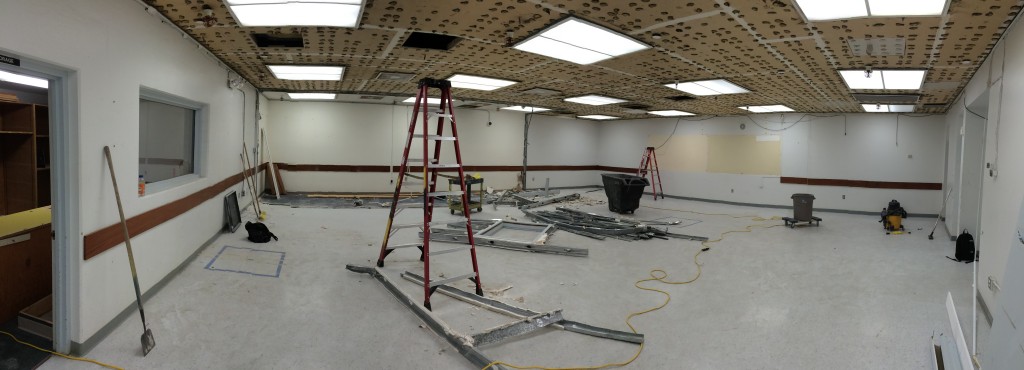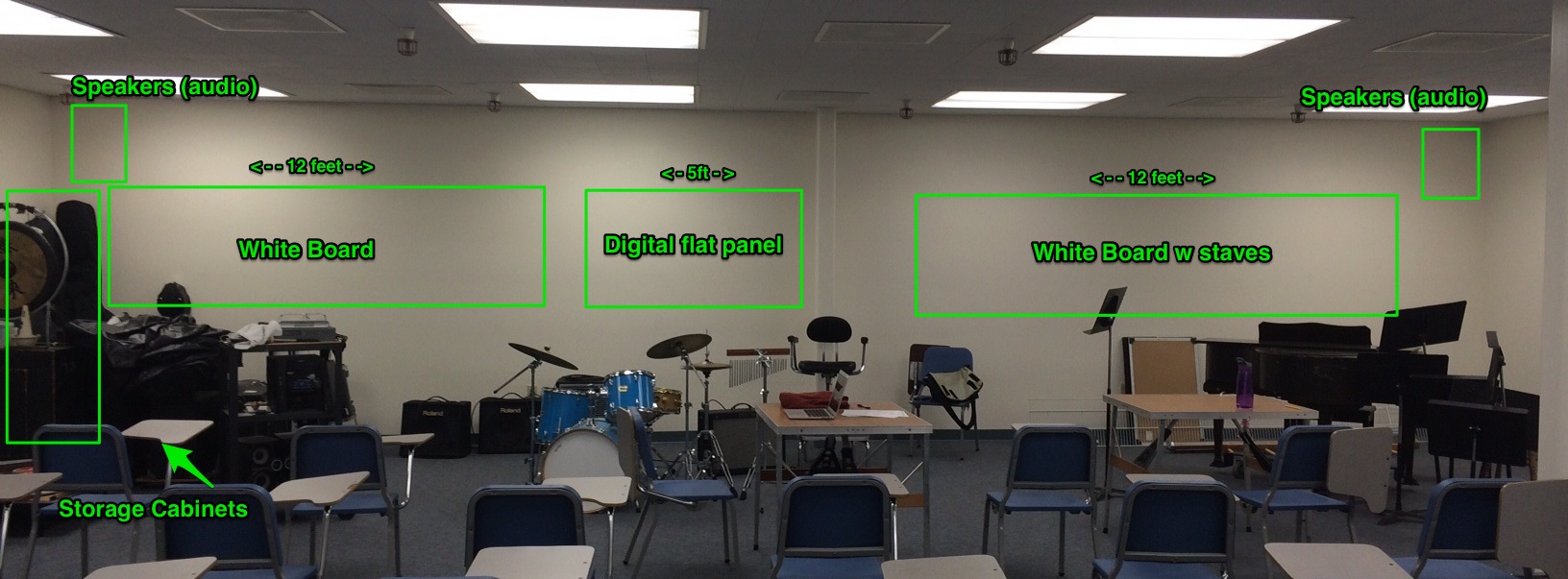Pump 13
/0 Comments/in play, reflection /by chadFuture Possibilities for Qualitative Research in Music Education
/0 Comments/in Music Education, reflection /by chadUbiquitous Learning
/0 Comments/in edReform, reflection /by chad“Today’s students will be a knowledge producer, drawing together a range of available knowledge resources – instead of a knowledge consumer, fed just one source, the old textbook. They will work effectively in pairs or groups on collaborative knowledge projects, creating knowledge to be shared with peers. They will continue to learn beyond the classroom, using the social media to learn anywhere and anytime – a phenomenon called ‘ubiquitous learning’.”¹
Here in the first quarter of the 21st century, Education must consider and wrestle with the notion of learning anywhere, at anytime and ask ourselves: how do I fit into my students learning experiences?
¹Kalantzis, Mary, and Bill Cope. “The Teacher as Designer: Pedagogy in the New Media Age.”E-Learning and Digital Media, vol. 7, no. 3, 2010, pp. 200–222.
The Music Festival
/0 Comments/in Conducting, reflection /by chadSince I began my tenure at St. Ignatius College Prep, I have taken the Chamber Singers to this festival for several reasons: the quality of Adjudication and the level of musicianship by the participating choirs. In the almost 10 years of it’s existence, it has become the Bay Area’s premier choral festivals. I particularly value this summative assessment for not only my students but for me as well. To my knowledge, it is one of the only assessments that evaluate students and their teacher simultaneously.
NVCC Comments and Ratings 20Mar2015 by czullinger
I was tremendously pleased with the students work the day of the festival. To be honest, I wasn’t exactly pleased with their level of preparation throughout the process. I gave several formative assessments before the festival and those results were somewhat mixed. In the future, I could use the scoring rubric for the festival as a template for their own evaluation in those assessments.
What was most interesting is that the piece the students intrinsically favor the most from the set is their weakest piece at this particular snapshot in the music’s evolution. All things considering, I knew going in the Esenvalds was a stretch for this particular ensemble, not because they can’t sing it, it’s just that the composition simply demands more than this choir is capable of producing. They are a High School chamber choir of 28 voices, and when I first was programming this festival set, I was captivated by my colleagues College choir of about 32 – undergraduate and graduate voice majors – sized ensemble.
Yet again, this piece won their hearts over and they love so much to sing this piece. Looking back, and looking forward, I don’t think I have found the right standing order so they can really hear each other adequately. Also, it is very difficult to tune the water glasses and achieve a consistent sense of intonation with the chimes and choir. At the retreat when we first learned the piece, I had 2 performers per pitch on the tuned water glasses; we performed with only 1 on a part at the performance. Our intonation (tuning) was not our strongest component that afternoon.
William Byrd’s Sing Joyfully, on the other hand, is a perfect selection for this choir. This music is difficult, mostly because singers in the 21st century can’t instantly recall the ‘sound’ of music over 400 years old in the same way they can differentiate between the subtleties of Hip Hop. It’s just not in their ears. In the learning process, this requires a lot of patience and vocal modeling. Over the years, I have observed Renaissance music for high school students has – to some degree – been motivating for them because they just want to figure it out, kind of like a puzzle. There is also a sense of satisfaction when these mostly linear phrases lock into vertical sonorities at cadential points along the way.
I also have been very cognizant of what it is the students are really trying to attain: a Unanimous Superior plaque or authentic music making and sharing. I really believe in the format of this particular choir festival. After the performance, each ensemble receives a 20 minute clinic from one of the Adjudicators in front of other students from participating schools. The festival focus has always been: Educational from the country’s top, collegiate choral directors and sharing choral music from exemplary High School choirs in the Bay Area (it is an Invitational choir festival). And yes, the performance is rated/graded (fortunately it is not ranked).
The students had some interesting thoughts about the experience that can be found here: http://sichambersingers.blogspot.com/2015/03/festival-thoughtscomments.html
Learning Space Makeover
/1 Comment/in Learning Space, reflection /by chadMy colleague and I inherited a teaching space with two primary purposes: a) Band rehearsal room, b) Music Appreciation classroom. This double wide classroom was used for this purpose for nearly two and a half decades before our arrival in 2008.
When my colleague and I arrived we continued to use the space for similar functions but soon realized the limitations of the space and began to conduct instrumental music rehearsals in larger, multi-purpose rooms, but the Band Room continued to be used for Music Appreciation classes. We cobbled together an old, gun-metal gray A/V cart with a used combo cassette, CD and AM/FM unit (with an AUX input) connected to a video projector that displayed content from our computers, complete with a pull-down screen! We used the space this way for a good 6 years before I attend my first ISTE conference last summer (2014 in Atlanta). During the conference, conversations with our Educational Technologist – whom I was traveling with – went something like this: if we had a space to “re-do” at school, what could it look like? Coincidentally, the Band Room and several other areas around campus had been scheduled for seismic retrofitting construction the same summer as the ISTE conference which was a perfect convergence, and opportunity to design and make this space into a 21st century learning environment.
Here is the room as it had been oriented since I had arrived at St. Ignatius College Prep. It was essentially a rehearsal room after school and a classroom during the regular school day.
Architectural Plans for installation of items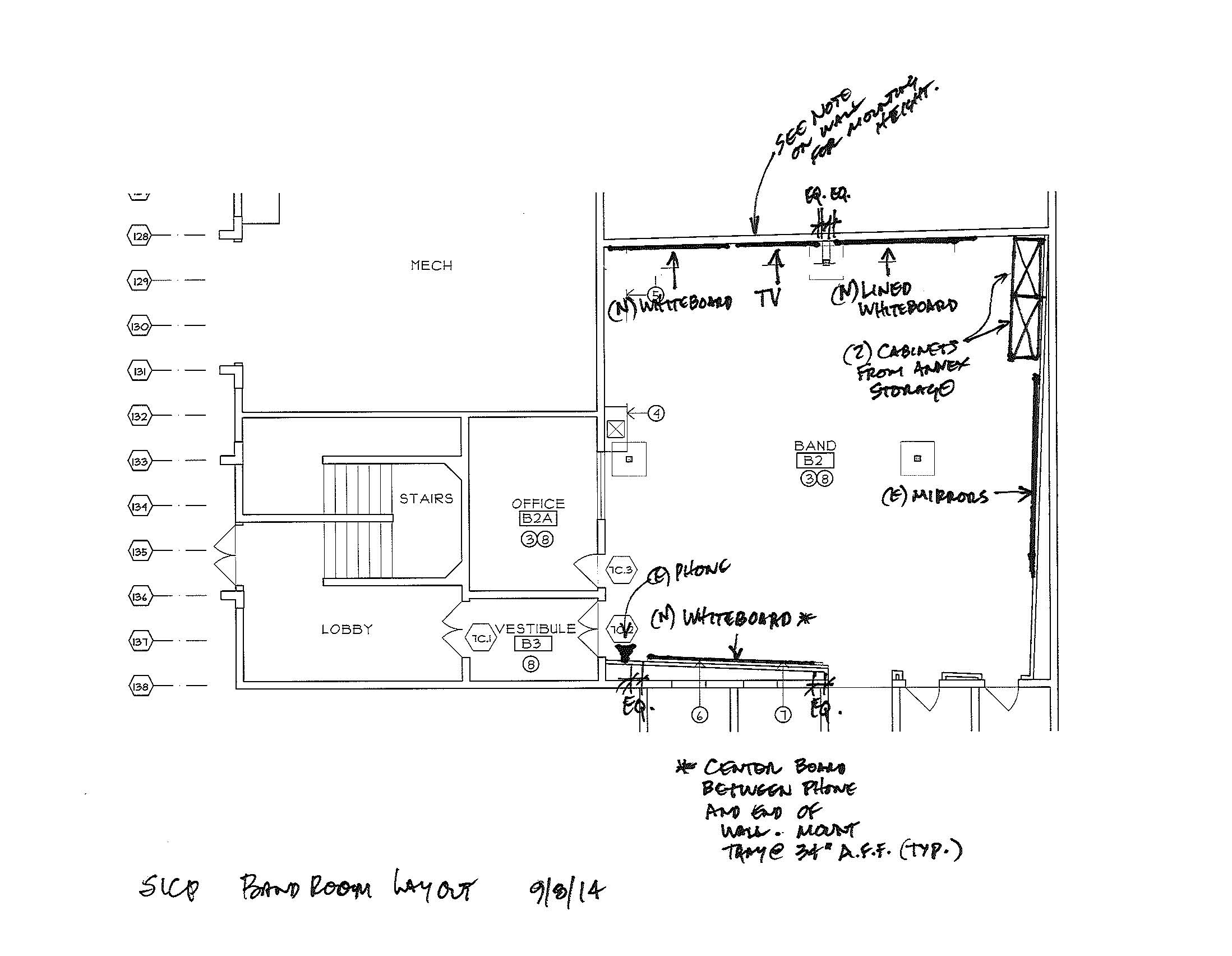
Stuff beginning to appear. Jamie and I setting up the flat screen (after mounting to the wall)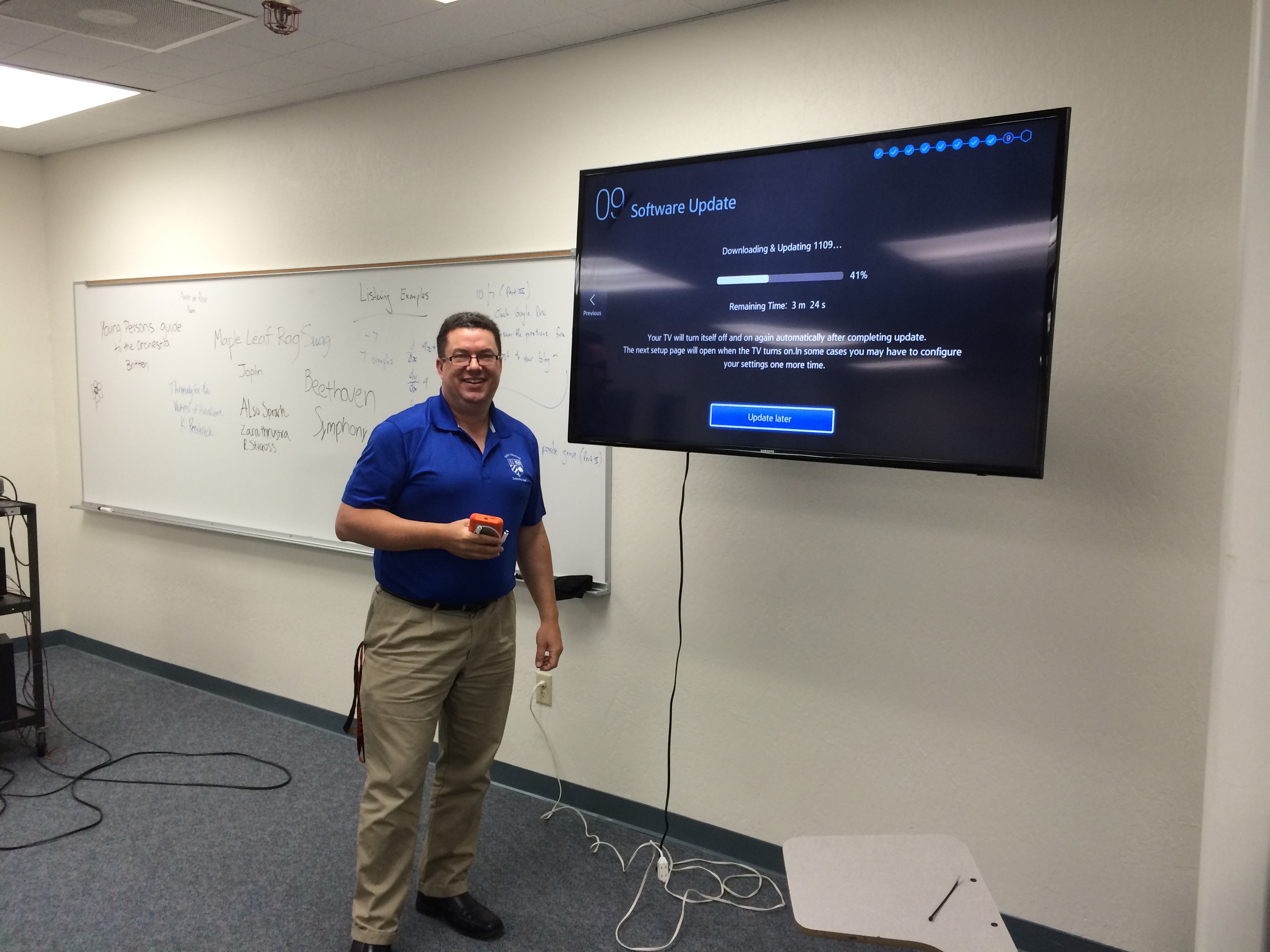
Learning space beginning to resemble Skitch drawings. Had to keep the old A/V cart around for good measure! Sitting next to it is an 12-channel Berhinger mixer connected to a Crown 300w amplifier which will power the 12″ Berhinger speakers mounted on the wall just above white boards. Affixed to the mounting bracket for monitor is an Apple TV for wireless connectivity.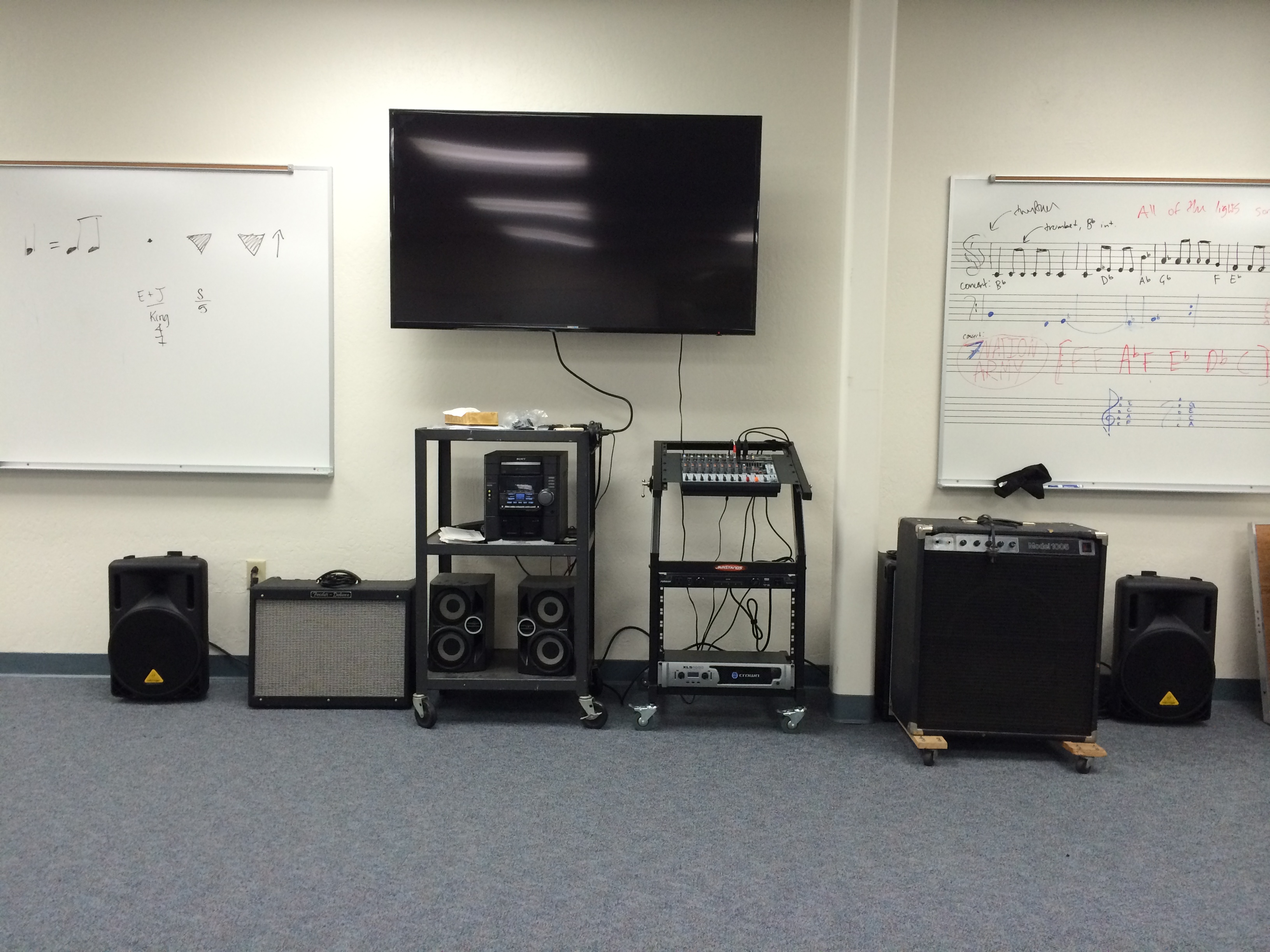
A few weeks ago I picked up a headphone preamp so we could start an iPad Band jam session. The space also has 5 iMacs around the perimeter of the room (seen here) for teams to use more robust versions of Garage Band and/or iMovie.
The next phase is to incorporate some furniture that encourages collaboration and creates group sectors or pod areas in the room. This would include chairs, tables and desks that are modular and mobile since the space is fairly large and could support a variety of classroom arrangements. I have some ideas from a company called Steelcase that I would love to outfit the room with sometime in the next 12-16 months. And finally, none of this is possible without sharing and the ideas from my colleagues Jamie Pruden and Eric Castro for their contributions in this project.
#weprovidepep
/1 Comment/in reflection, work /by chadLetter to SI Chamber Singers, Fall 2014
/0 Comments/in Conducting, reflection, work /by chadIn the spirit of “Dear People” the book by Joseph A. Mussulman that compiled letters Robert Shaw wrote to his choirs, I wanted to share some thoughts I had about this particular piece with the 2014-15 Chamber Singers in November 2014. At the end, there is a video of us performing the piece at St. Ignatius Church in San Francisco, CA on Friday, December 19, 2014.
Hello gang,
I sat in a soprano and alto sectional a few weeks back and was struck at the very simple question Ms Hollow, one of our vocal coaches, asked the gals, “what does Resmiranda mean?”. I came in towards the end of the sectional and it was obvious that they learned what the phrase meant (wonderful circumstance and/or happening).
I have been personally drawn to this piece and text for quite some time now. This recording we have is by a high school group my wife sang in when she was a senior in high school (Vintage High School Chamber Singers ’94). Her teacher eventually became my graduate school mentor – this is a great story in itself, but back to the story at hand.
There is No Rose is an English carol that dates back to the Middle Ages c.1420. The text is written in two languages: Middle English and Latin. Most fascinating to me are the marriage of musical elements with the rich allegories infused in the text. This idea of “little space” which is Mary’s womb, where heaven and earth meet, and how it interweaves the Latin of the Church with the English of the common people — as if interweaving spiritual and secular themes, symbolically, through the use of two languages. And finally, the phrase Transeamus or let us cross over is set to just about one of the most amazing clips of choral music around. Let us cross over. Where is it that we begin and where do we move to? Is the choral ensemble a bridge for all that is human and all that is divine?
Honestly, I truly believe this is music. It is a vehicle, a bridge, for all that is divine and all that is human in the hopes that in the center we catch a glimpse in either direction. There are pieces of music out there that are simply transcendent for me. Occasionally, an ensemble emerges through days of interviews, hours of auditions and of course time spent with one another that are capable of not only re-producing what’s on the page – musically and vocally) – but are open enough to peek into all that is possible from the page: You are this ensemble.
You all have the potential to unlock the mystery of this piece and share with your audience. Having said that, it does require note/rhythm accuracy, attention to phrasing and all the musicality that is required by any piece of music, but it also requires a vulnerability, a clear picture of how this piece sounds and feels when it is right in you. There is No Rose is one of those pieces that helped me confirm that this guitarist wanted to stand in front of choirs and make music with one another. Those stories my wife shared with me my first years teaching, and this particular recording helped me conceive what is possible by a group of people who are drawn to a) the collective effort b) those in the world that think and feel.


